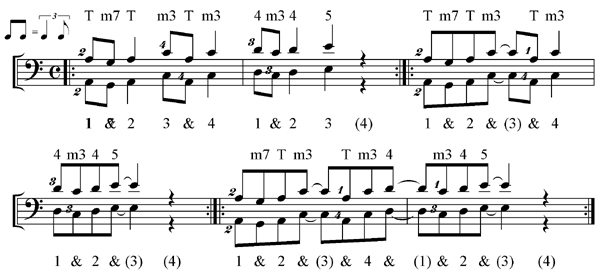Musicarta Pentatonics Workbook
Pentatonic Riffs in A Minor
Page Two
Riffing on the notes of the minor pentatonic scales is quite easy and sounds great if you add some off-the-beat rhythms. Musicarta’s step-by-step rhythmic build-up shows you how.
Here’s a reminder of the A minor pentatonic scale you’ll be using in this riff.

Play the notes at your keyboard. Sing the scale to yourself from T to T and
back:
tonic, minor third, fourth, fifth, minor seventh (going up)
For ear training, look at random pentatonic scale tones in the main octave one at a time see if you can sing them in your head. Then check your guess against the keyboard.
The main riff
Listen to the riff performance
until you know it fairly well.
Rhythmic build-up
This page has a step-by-step rhythmic build-up which will teach you many syncopated mini-riffs in the minor pentatonic scale. If you work through the build-up thoroughly, you will be able to play the main riff and use these fragments and skills over and over in your playing.
The first few practice segments for this riff are written ‘in unison’ – with both hands playing the same notes an octave apart. You can practice just the right hand (most important) to start with.
This section deals with anticipation. Anticipation is pulling notes forward off their number beat (1, 2, 3, 4) into the previous quaver slot, to give music a more funky sound.
The music below covers the first three videos.

|
First, notice the instruction to use ‘swing quavers’ – the "Dum-di, dum-di, dum-di" ‘triplet quaver feel’ or 'shuffle beat'. |
 |
Here's the first part; there is no anticipation.
Prepare the A's on the keyboard (both below middle C) with the fingers indicated.
You get 'four in', then the hands are shown playing the pattern four times, then you get to play along four times. Keep going at the end.
In the second video, beat 3 gets pulled forward (anticipated) onto beat 2’s ‘and’. Nothing plays on beat 3, so you see (3) in brackets in the counting on the music.
COMINGThe third time (last two bars), even the second bar beat 1 is anticipated.
COMINGKeep working with each section until you can repeat the final version indefinitely.
PRACTICE SECTION 2
The riff doesn’t actually start on the first beat of the bar. There’s a ‘lead-in’ on beats ‘& 4’.
Try to tap your foot
and count out loud “One, (two, three) and four” (un-syncopated - 'straight'), as you copy the performance. (We know, this is NOT easy!)

Then "One (two, three) and four and (one)" in the second, syncopated type.

Then you get to alternate between the two types.
(A lot of pupils find it harder going back to the 'straight' version. Syncopation is contagious!)



Together-left-right analysis
When the hands are doing different things, together-left-right analysis (T, L or R written above the music) sometimes becomes useful.
Together-left-right analysis gives you the opportunity to think clearly about whether your hands play together, or whether just the left or just the right hand plays.
If you ever just can’t get a practice pattern, drop the rhythm and speed altogether and look
at the TLR analysis only. Tap out the TLR ‘events’ on your
desktop (i.e. away from your keyboard) without any rhythm at all over and over until it feels natural.
Then put the rhythm back in.
When you can the together, right, left
‘events’ in order and in rhythm, go back to the keyboard and play it with the
notes.
PRACTICE SECTION 5
To complete our mini-riff we need a 'second type'.
Here it is - a lot of off-the-beat playing, and the left-hand lead-in joins in the syncopation too.
Beats 1, 2 and 3 are anticipated – only count 4 actually has notes on the beat. You can hear how much the anticipation adds to the funky feel.
Here is the ending fitted onto the phrase, played continuously to practice.

Now you can play the whole of the first part of the riff, a fine little stand-alone performance, especially if you're new to this type of syncopated playing.
Here is your performance to copy. (I'm afraid that darn syncopation has crept into the first lead-in left hand. Imitate or not "ad lib"!)
Get that down, then go on to Page Three of this module for the second half of the riff.
Thanks for visiting Musicarta.com! Come back soon!
|
OUT NOW! |
THE MUSICARTA BEAT & RHYTHM WORKBOOK At last! An effective approach to keyboard rhythm & syncopation skills. Learn more! |
ONLY $24.95! |
|
THE MUSICARTA PENTATONICS WORKBOOK video course Home/Index pages The Pentatonic Scales
Practice Patterns
Melody Work and
Playing by Ear
Pentatonic Riffs
and Diaries - Minor Pentatonic Major Pentatonic
Chromatic Minor
Chromatic Major
Pre-video Pages
Pentatonics videos
Archive Pages
|
The MusicartaA methodical approach to keyboard syncopation for
|
PUBLICATIONS
exciting keyboard
creativity courses
CHORDS 101
WORKBOOK

~HANON~
video course

Musicarta
Patreon
PENTATONICS
WORKBOOK
video course

Creative Keyboard
video course

BEAT AND RHYTHM
WORKBOOK

- Volume 1 -

12-BAR PIANO
STYLES WORKBOOK

MUSICARTA MODES
WORKBOOK

PIANO STYLE

CANON PROJECT
video course

VARIATIONS
video course


- Piano Solo -
video course

- Piano Solo -


YouTube playlists


